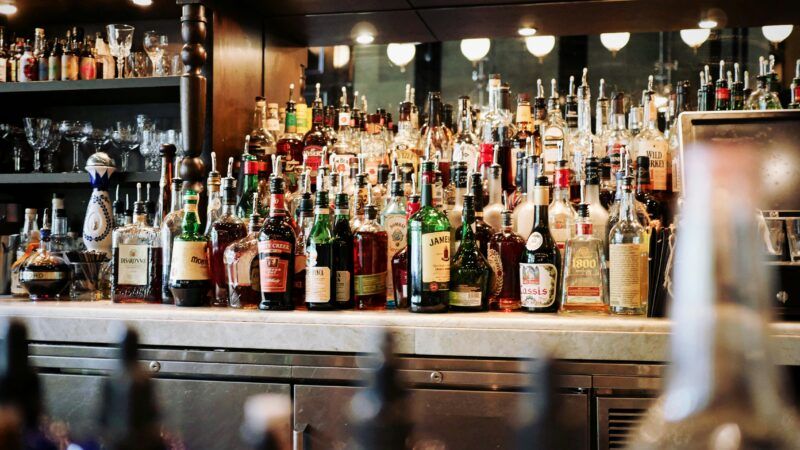Virginia May Finally Fix a Dumb Drink Law
The infamous food-beverage ratio may be reformed, but not abolished.

When it comes to identifying America's most ridiculous and nonsensical alcohol law, there are many ignominious candidates to choose from. But Virginia's infamous food-beverage ratio certainly deserves a spot on any list of the dumbest drink laws in the country. A plucky coterie of Virginia policy makers has sought to reform the commonwealth's beverage ratio for years, only to run into a buzzsaw of special interest cronyism. But suddenly there is hope for boozy freedom.
Virginia's food-beverage ratio mandates that restaurants earn $45 in food sales for every $55 they take in selling liquor-based drinks. This may sound innocuous at first, but it has the effect of making establishments like elite cocktail lounges or high-end whiskey bars—which often offer scotch pours costing upwards of a thousand dollars—nearly impossible to operate in the commonwealth. After all, it takes a lot of food sales to offset a single $2,000 shot of Macallan M under the ratio. The rule also creates burdensome record-keeping requirements for restaurants, who are forced to prove they have not violated the ratio each year.
The provenance of Virginia's ratio (at least spiritually) traces back to the Prohibition era, when it was, of course, illegal for any restaurant to sell alcohol. In 1968, the state Legislature passed the Mixed Beverage Act, which stipulated that restaurants could not make more money from booze than food. The law underwent several iterations in the 1980s and '90s before reaching its current 45–55 ratio. Bizarrely, in the 1990s, beer and wine were arbitrarily exempted from counting toward the ratio, meaning it has only applied to liquor sales since that time.
The upshot is that a craft brewery in Virginia can sell as much beer as it wants—even booze-bomb Imperial IPAs—without so much as a trace of food on the premise, while a cocktail lounge that specializes in, say, gourmet hot dogs and sophisticated drinks might have trouble even opening in the first place. This makes little sense given that defenders of the law argue that the point of the ratio is to reduce the potential level of intoxication among patrons of drinking establishments.
Some of the lawmakers defending the ratio even went so far as to invoke the language of Prohibition, such as then-Senate Minority Leader Richard Saslaw (D–Fairfax County) growling in 2015: "If you can't meet that ratio, you ain't running a restaurant, you are running a bar. If you want saloons in Virginia, say so." Opponents painted a doomsday picture of "bars on every corner" of the commonwealth—all while conveniently overlooking neighboring Washington, D.C., which does not have a ratio or a saloon epidemic.
If anything, the ratio is actually more likely to incentivize lower-end "saloons" or "gin mills" at the expense of the aforementioned high-end cocktail lounges and whiskey bars. Once again, that's because it is a lot easier to meet the ratio by selling $4 rail drinks with rotgut spirits than by selling $350 pours of Pappy Van Winkle. During state budget shortfalls in the past, lawmakers have further compounded the problem by increasing the costs of liquor at state-run Alcoholic Beverage Control (ABC) stores to raise more revenue, which in turn forces restaurants to increase food prices to account for this increase in liquor prices. In this way, the ratio even impacts nondrinkers by acting as a form of stealth taxation on food in the commonwealth.
Unsurprisingly, the real reason the ratio persists is that an influential group of Richmond restaurateurs has heavily lobbied the state Legislature for years to keep it in place. Rather than being motivated by altruistic concerns over protecting the public from the purported terrors of saloons, these business owners are actually worried about upstart competitors like speak-easies and cocktail bars—which are becoming increasingly popular amid the ongoing craft spirit boom—from undercutting their bottom line.
This protectionist influence has acted as an iron curtain repelling repeated efforts to change or modify the ratio. But just when it appeared all hope was lost for fixing the ratio, a recent reform bill suddenly started flying through legislative committees and has now improbably passed the state Senate unanimously. The unexpected success of this reform effort seems to be attributable to turnover in the Legislature and the retirement of old-guard senators like Saslaw.
Should the legislation also clear the House of Delegates and make it to Gov. Glenn Youngkin's desk, it would reduce the food-beverage ratio from 45–55 to 35–65 for restaurants with monthly food sales below $10,000, and it would outright eliminate the ratio for restaurants exceeding that threshold. Ideally, the ratio would be axed for all establishments, regardless of their monthly food sales—especially given that beer and wine sales are already unlimited in Virginia.
Outright elimination of the ratio may have to wait for a future time, but Virginia is on the precipice of at least severely kneecapping one of the worst laws in its code book. If it does, it will serve as an all-too-rare example of free market champions finally outlasting the protectionists.


Show Comments (39)